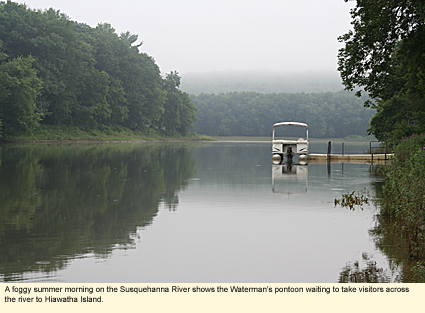Home > Recreation > Nature CentersNature Centers in the Finger LakesWaterman Center403 Hilton Rd.
Located in Tioga County, the Fred L. Waterman Conservation Education Center's main facility is an interpretative center on Hilton Road, which houses a museum, a nature shop, classrooms, a reference library, and offices. Outside the interpretative center are the Lolita Waterman Wildlife Gardens, designed to teach landowners how to incorporate native plants into their own landscapes. There are also 4.5 mi./7.2 km. of marked hiking trails through 94 acres of a variety of habitats, including a lovely woods with many native plants and fungi, a gorge with a waterfall, and regenerating fields. If you have time for only one trail, take the red trail, which provides a taste of everything.
In addition, the Waterman Center operates four wildlife refuges at different locations. Dogs are not permitted on any of the Waterman properties.
Apalachin MarshThe marsh and adjoining woods is located in Apalachin between the east-bound and west-bound lanes of State Route 17, a major 4-lane highway across the southern tier of New York State. Access is from State Route 434 in Apalachin about. 5 mi/.8 km. west of the intersection of 434 with Hilton Road. Here you will find a pull-off area and a marked path to a culvert under the highway.
Once on the other side of State Route 17, you enter a woods with lovely, old specimens of native trees, like white pine, shagbark hickory, and black cherry. Interpretative signs and benches are available to help people relax while they enjoy the area's abundant flora and fauna. Wildlife: The size of the marsh is estimated at between 40 and 50 acres. Along with the woods, the site makes an excellent place to watch birds and other wildlife. The area is well known as a place with excellent birding of warblers and other woodland birds, ducks, rails, hawks, and many other birds. A marked trail through the woods leads to a blind (hide) from which one can view the marsh without disturbing the birds. There is no path around the marsh, so the viewing of birds is best done with a spotting scope. In the spring, the water of the marsh is open, but it quickly fills with waterlilies by summer. This and the fact that there is no shore for birds to congregate on limits the number of birds that stay during the summer. Early mornings are best but may be foggy due to the proximity of the Susquehanna River.
Brick Pond Wetland PreserveAlong with Apalachin Marsh, Brick Pond is considered one of the best birdwatching sites in New York State. Once used by the Hollenbeck family for the excavation of the blue-gray clay used to make bricks, Brick Pond in Owego consists of 30 acres of open water surrounded by wetland plants and moist woods. A trail of about .5 mi./.8 km. around the pond provide visitor access.
The GlenLocated in the Town of Union, the Glen provides 200 acres of mature forest, a gorge with waterfalls, and abundant wildflowers and wildlife. A trail with stone steps and a series of bridges, including two stone arch bridges, leads to stone fireplaces and picnic tables. Snowshoeing and cross-country skiing are permitted in the winter. brochure
Hiawatha IslandHiawatha is a 112-acre island in the Susquehanna River between the towns of Owego and Apalachin. The Center owns 15 acres of riparian woodland on the mainland near the island and operates a pontoon boat named The Susquehanna Shuttle that takes visitors to the big island for special tours and events.
Updated 16 July 2010
|
|
|


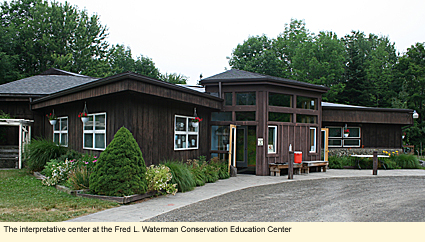
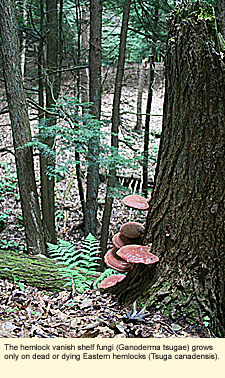 Wildlife: Because there is water in the woods and because the fields have regenerated to a thick stand of shrubs and young trees, you should expect to see a wide variety of mammals, like chipmunks, squirrels, raccoons, deer, and foxes to name just a few. Birds will be in great abundance during migration and breeding. You can expect to see woodpeckers, vireos, thrushes, many species of warblers, house wrens, chickadees, nuthatches, catbirds, towhees, several species of sparrows, blue jays, and others.
Wildlife: Because there is water in the woods and because the fields have regenerated to a thick stand of shrubs and young trees, you should expect to see a wide variety of mammals, like chipmunks, squirrels, raccoons, deer, and foxes to name just a few. Birds will be in great abundance during migration and breeding. You can expect to see woodpeckers, vireos, thrushes, many species of warblers, house wrens, chickadees, nuthatches, catbirds, towhees, several species of sparrows, blue jays, and others.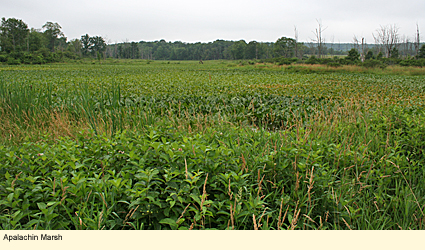

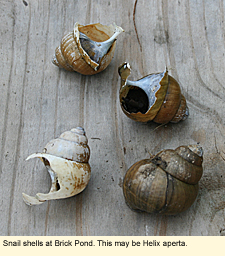 Wildlife: The actual wetland area is much larger, but Brick Pond is the only portion open to the public. The large wetland, rather long and narrow, surrounded by tress and bordered by a railroad track, means that you are likely to see many birds that don't usually frequent ponds. You should be able to see muskrats, lots of reptiles and amphibians, Canada geese, great blue and green herons, several species of ducks including wood ducks, red-winged blackbirds, vireos, chickadees, woodpeckers, American robins, catbirds, and others. You may hear rails and sedge wrens, though you probably won't see them. There used to be beavers, but they have cleared out most of the food, so you probably will not see them, though some trees show signs of having been gnawed in the past.
Wildlife: The actual wetland area is much larger, but Brick Pond is the only portion open to the public. The large wetland, rather long and narrow, surrounded by tress and bordered by a railroad track, means that you are likely to see many birds that don't usually frequent ponds. You should be able to see muskrats, lots of reptiles and amphibians, Canada geese, great blue and green herons, several species of ducks including wood ducks, red-winged blackbirds, vireos, chickadees, woodpeckers, American robins, catbirds, and others. You may hear rails and sedge wrens, though you probably won't see them. There used to be beavers, but they have cleared out most of the food, so you probably will not see them, though some trees show signs of having been gnawed in the past.